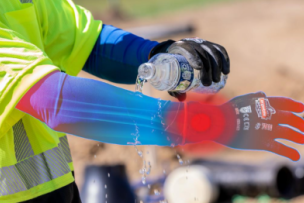Abrasions vs. Lacerations
What is the difference between an abrasion and a laceration? Like the subtle distinctions between cuts and lacerations, abrasions and lacerations seem similar, but the cause and impact of the injury are a bit different. Abrasions are typically mild injuries that directly result from friction, rubbing, or scraping across a rough surface. With an abrasion, the skin is damaged because the rough surface scrapes away a layer—or several layers—of skin. They are the most superficial skin wound and only reach the epidermal skin layer.
While it may be challenging to determine whether an injury is a laceration or an abrasion, one factor to consider is the amount of blood. Abrasions don't usually bleed as heavily as cuts or lacerations because only the epidermis skin layer is injured. They also heal faster than cuts and lacerations. However, abrasions still need to be cleaned with soap and water to prevent infection.
Types of Wounds
Laceration wounds often occur due to knives, tools, and machinery accidents. As MCR Safety reports on their Cut Protection education page, tools are the #1 cause of cut and laceration injuries, followed by parts and materials. And lacerations don't just affect hands or arms—it is essential to protect eyes from laceration hazards, too.
Lacerations can happen anywhere on the body, but workers may be especially vulnerable to lacerations on their hands and arms, which are often more exposed on the job site. If eyes are left unprotected, one's eyes are also vulnerable to lacerations.
Arm and Hand Lacerations
A laceration to the hand or arm can lead to numbness, weakness, swelling, and tingling—especially if there is damage to the nerves that run through the hand.
Depending on the cause and severity of the hand injury, there may be bruising and swelling, which can impact the nerve and seem like nerve damage. Once this bruising subsides, if numbness, tingling, and weakness in the hand still occur, the injured person should seek laceration repair, and follow up with their physician to determine potential treatment options.
Eye Lacerations
The skin is not the only organ that can incur a laceration. The cornea, the transparent front layer of the eye, can also be lacerated, resulting from something sharp flying into the eye or striking it with significant force. If a corneal laceration is deep enough, it can lead to the laceration of the entire eye. A corneal laceration is deeper and more severe than a corneal abrasion and can quickly happen in the workplace when the appropriate eye protection is not worn. If a corneal injury is believed to have occurred, one should seek immediate medical attention as it's a severe injury. An ophthalmologist should perform a complete eye examination and assess what steps are needed to repair the injury.
Cutting wood and grinding metal are two applications where people are at high risk of eye injuries. Lacerations can also happen when someone does something as benign as cutting the grass—especially if debris is caught in the mower's blades and sent flying.
Treatment
Minor cuts and lacerations can often be treated with gauze, bandages, and antibiotic ointment after a thorough cleaning. However, deep lacerations require treatment from a medical professional, as the wounds can involve a great deal of blood loss. If a major artery has been cut in a laceration-related injury, a person can bleed out in as few as 5 minutes.
It's also critical to seek medical attention right away if you have a crush injury or any partial amputation. Additionally, deep wounds or wounds that are not closing and healing on their own also call for professional medical care.
Healthcare providers may utilize stitches or skin glue to hold the torn skin in place and facilitate healing. Skin glue can be used for smooth, shallow lacerations, and stitches are used for deep or jagged cuts. Combining the two techniques may also be used to hold lacerations together.
Some lacerations can be treated with a first aid kit, so here are some basic first aid tips you should know when treating a wound.
Control the Bleeding
The first step to address a laceration is minimizing blood loss by applying pressure to the impacted area and elevating it to the heart's height. If this is not enough to stop the bleeding, you can apply pressure to the closest central pressure point—like the crook of the elbow for a laceration on the forearm. Tourniquets should only be used if treatment is not feasible for several hours.
Thoroughly Clean the Wound

Dirt, dust, and bacteria can easily make their way into a laceration, especially on the job site. Your wound should be washed gently and thoroughly with warm water and mild soap.
Care for Your Wound
Minor wounds may only need a bandage and antibiotic ointment, but the bandage should always be kept clean and dry and changed regularly.
Keep Your Eye on the Injury
If the laceration becomes warm to the touch, appears red, bleeds excessively for an extended period, or has drainage, it may be infected. This infection can spread quickly through the body, so seek medical care. Keep in mind that deep lacerations can impact tendons and nerves. If you have lost motion or feeling in the area surrounding your laceration, you may have cut through or damaged a tendon or nerve. See your physician as soon as possible.
Continue to read this blog to learn about cut-resistant gloves and safety glasses from MCR Safety to help prevent lacerations in the workplace or on the job site.
Previously Featured on MCR Safety's blog.











Talk to Us!
Leave a reply
Your email address will not be published. Required fields are marked *